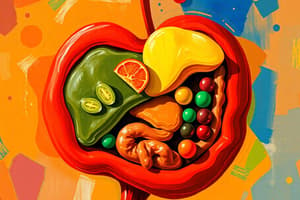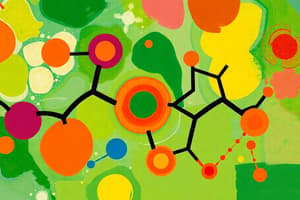Podcast
Questions and Answers
Which organ primarily secretes pepsinogen for protein digestion?
Which organ primarily secretes pepsinogen for protein digestion?
- Liver
- Stomach (correct)
- Pancreas
- Small intestine
What is the role of hydrochloric acid (HCl) in protein digestion?
What is the role of hydrochloric acid (HCl) in protein digestion?
- To kill bacteria and denature proteins (correct)
- To activate proteolytic enzymes
- To hydrolyze polypeptides into amino acids
- To absorb amino acids in the intestine
Which of the following statements about amino acids is incorrect?
Which of the following statements about amino acids is incorrect?
- Excess amino acids are rapidly degraded.
- The body stores amino acids for later use. (correct)
- Amino acids can be derived from dietary proteins.
- Amino acids contribute to the synthesis of hormones.
Which pancreatic enzymes are involved in further cleaving polypeptides in the small intestine?
Which pancreatic enzymes are involved in further cleaving polypeptides in the small intestine?
What triggers the conversion of pepsinogen into its active form?
What triggers the conversion of pepsinogen into its active form?
Which statement best captures the process of protein digestion in the stomach?
Which statement best captures the process of protein digestion in the stomach?
What happens to excess amino acids that exceed biosynthetic needs?
What happens to excess amino acids that exceed biosynthetic needs?
What is the primary outcome of gastric digestion of proteins?
What is the primary outcome of gastric digestion of proteins?
What role does enteropeptidase play in zymogen activation?
What role does enteropeptidase play in zymogen activation?
Which of the following conditions leads to steatorrhea due to inadequate enzyme secretion?
Which of the following conditions leads to steatorrhea due to inadequate enzyme secretion?
What is the primary mechanism through which free amino acids are absorbed into enterocytes?
What is the primary mechanism through which free amino acids are absorbed into enterocytes?
Which of the following statements is true regarding the absorption of di- and tripeptides in the intestine?
Which of the following statements is true regarding the absorption of di- and tripeptides in the intestine?
Which amino acids are NOT metabolized by the liver?
Which amino acids are NOT metabolized by the liver?
What is the cause of malabsorption in celiac disease?
What is the cause of malabsorption in celiac disease?
What is a manifestation of transport defects in amino acid uptake?
What is a manifestation of transport defects in amino acid uptake?
What is primarily excreted as a result of amino acid metabolism?
What is primarily excreted as a result of amino acid metabolism?
Which enzyme plays a crucial role in the cascade of proteolytic activity initiated by trypsin?
Which enzyme plays a crucial role in the cascade of proteolytic activity initiated by trypsin?
Which process involves the transfer of an amino group to form glutamate?
Which process involves the transfer of an amino group to form glutamate?
During protein turnover, what maintains the total amount of protein in the body?
During protein turnover, what maintains the total amount of protein in the body?
What happens to most of the free ammonia produced from amino acid catabolism?
What happens to most of the free ammonia produced from amino acid catabolism?
Which of the following accurately describes the amino acid pool?
Which of the following accurately describes the amino acid pool?
What is the first phase of amino acid catabolism?
What is the first phase of amino acid catabolism?
Which statement is true regarding nonessential amino acids?
Which statement is true regarding nonessential amino acids?
What primarily occurs after the removal of the α-amino group from an amino acid?
What primarily occurs after the removal of the α-amino group from an amino acid?
Which amino acids do not participate in transamination reactions?
Which amino acids do not participate in transamination reactions?
What is the main role of alanine aminotransferase (ALT) in amino acid metabolism?
What is the main role of alanine aminotransferase (ALT) in amino acid metabolism?
In what scenario would elevated levels of aminotransferases be most indicative of a nonhepatic disease?
In what scenario would elevated levels of aminotransferases be most indicative of a nonhepatic disease?
Which enzyme is responsible for the oxidative deamination of glutamate?
Which enzyme is responsible for the oxidative deamination of glutamate?
What is the result of oxidative deamination of amino acids in the liver?
What is the result of oxidative deamination of amino acids in the liver?
Where are alanine aminotransferase (ALT) and aspartate aminotransferase (AST) predominantly found?
Where are alanine aminotransferase (ALT) and aspartate aminotransferase (AST) predominantly found?
Which of the following statements about amino acid participation in transamination is correct?
Which of the following statements about amino acid participation in transamination is correct?
What does an elevated plasma level of aminotransferases typically indicate?
What does an elevated plasma level of aminotransferases typically indicate?
Flashcards
Stomach Digestion of Proteins
Stomach Digestion of Proteins
Dietary proteins undergo initial breakdown in the stomach by pepsinogen, an inactive proenzyme that gets converted to active pepsin in the presence of HCl.
HCl's Role in Protein Digestion
HCl's Role in Protein Digestion
HCl, secreted by parietal cells, plays a critical role in protein digestion by denaturing the proteins, making them more susceptible to enzymatic attack.
Endopeptidases vs. Exopeptidases
Endopeptidases vs. Exopeptidases
Endopeptidases cleave internal peptide bonds in proteins, while exopeptidases break peptide bonds at the ends, generating smaller polypeptides and individual amino acids.
Complete Protein Digestion
Complete Protein Digestion
Signup and view all the flashcards
Amino Acid Storage
Amino Acid Storage
Signup and view all the flashcards
Roles of Amino Acids
Roles of Amino Acids
Signup and view all the flashcards
The Amino Acid Pool
The Amino Acid Pool
Signup and view all the flashcards
Catabolism of Amino Acids
Catabolism of Amino Acids
Signup and view all the flashcards
What are zymogens?
What are zymogens?
Signup and view all the flashcards
How is the first zymogen activated?
How is the first zymogen activated?
Signup and view all the flashcards
What happens when pancreatic enzyme secretion is deficient?
What happens when pancreatic enzyme secretion is deficient?
Signup and view all the flashcards
What is the cause of celiac disease?
What is the cause of celiac disease?
Signup and view all the flashcards
How are oligopeptides further digested in the small intestine?
How are oligopeptides further digested in the small intestine?
Signup and view all the flashcards
How are amino acids and small peptides absorbed in the small intestine?
How are amino acids and small peptides absorbed in the small intestine?
Signup and view all the flashcards
What is special about branched-chain amino acids (BCAAs)?
What is special about branched-chain amino acids (BCAAs)?
Signup and view all the flashcards
What can happen when amino acid transport systems are disrupted?
What can happen when amino acid transport systems are disrupted?
Signup and view all the flashcards
Transamination
Transamination
Signup and view all the flashcards
Aminotransferase
Aminotransferase
Signup and view all the flashcards
Oxidative Deamination
Oxidative Deamination
Signup and view all the flashcards
Glutamate Dehydrogenase (GDH)
Glutamate Dehydrogenase (GDH)
Signup and view all the flashcards
Glutamate
Glutamate
Signup and view all the flashcards
Amination
Amination
Signup and view all the flashcards
Alanine Aminotransferase (ALT)
Alanine Aminotransferase (ALT)
Signup and view all the flashcards
Aspartate Aminotransferase (AST)
Aspartate Aminotransferase (AST)
Signup and view all the flashcards
What is the Amino Acid Pool?
What is the Amino Acid Pool?
Signup and view all the flashcards
How is the Amino Acid Pool Depleted?
How is the Amino Acid Pool Depleted?
Signup and view all the flashcards
What is Protein Turnover?
What is Protein Turnover?
Signup and view all the flashcards
What is the first step in Amino Acid Catabolism?
What is the first step in Amino Acid Catabolism?
Signup and view all the flashcards
Explain the process of Transamination.
Explain the process of Transamination.
Signup and view all the flashcards
What happens to the Carbon Skeletons of Amino Acids?
What happens to the Carbon Skeletons of Amino Acids?
Signup and view all the flashcards
Why is Nitrogen Removal Important?
Why is Nitrogen Removal Important?
Signup and view all the flashcards
Why is the α-aminogroup important?
Why is the α-aminogroup important?
Signup and view all the flashcards
Study Notes
Digestion and Catabolism of Proteins and Amino Acids
- Proteins are large molecules not directly absorbed by the intestine
- Protein digestion begins in the stomach with hydrochloric acid (HCl)
- HCL denatures proteins and kills bacteria
- Pepsinogen (an inactive zymogen) is converted to pepsin (active enzyme) via HCl
- Pepsin cleaves proteins into smaller peptides and some free amino acids
- Pancreatic enzymes, including endopeptidases and exopeptidases, further breakdown polypeptides into oligopeptides and amino acids in the small intestine
- Enterokinase, a brush border enzyme on the small intestine wall, activates the pancreatic enzyme trypsinogen to trypsin
- Trypsin then activates other pancreatic zymogens (e.g., chymotrypsinogen, proelastase)
- Oligopeptides are further broken down into smaller peptides and free amino acids in the small intestine by enzymes like aminopeptidases
- Free amino acids, di- and tripeptides are absorbed into enterocytes
- Branched-chain amino acids (BCAAs) bypass the liver and go directly into the bloodstream.
Amino Acid Catabolism
- Amino acid catabolism is part of overall nitrogen metabolism
- N containing molecules in food enter the body and convert to urea, ammonia and other substances
- The role of body proteins during transformation is involved with two concepts, this includes amino acid pool and protein turnover
Amino Acid Pool
- Formed by: degradation of endogenous proteins (body proteins); amino acids from dietary protein; synthesis from simple intermediates in metabolism
- Depleted by: synthesis of body proteins; building essential nitrogen containing small molecules; conversion to glucose, glycogen, fatty acids, ketone bodies or to CO2 and H2O
Protein Turnover
- Proteins are constantly being synthesized and broken down
- The rate of protein synthesis matches the degradation hence the total protein level remains constant
A.A Catabolism Phases
- Phase 1: Removal of amino groups: Amino groups are removed to form ammonia and a-keto acids in an a-amino group removal process
- Phase 2: Degradation of Carbon Skeletons: The carbon skeletons of amino acids are converted into intermediates for the central pathways of metabolism turning to carbon dioxide and water, glucose, fatty acids or ketone bodies
Nitrogen Removal from Amino Acids
- The a-amino group must be removed from amino acids to be used for energy production
- After removal, the nitrogen can be incorporated into other compounds or excreted as urea
- Amino acids are essential for generating energy
- The process involves transamination and oxidative deamination
Transamination
- Transfer of the amino group from an amino acid to a-keto acid, generating a new amino acid and a new a-keto acid.
- The reaction involves the transfer of an amino acid to an alpha-keto acid, with the resulting creation of an alpha-keto acid and a non-essential amino acid (such as glutamate).
- ALT and AST catalyze transamination, with a vitamin B6 as a co-factor
Oxidative Deamination
- Removal of the amino group from amino acids to produce ammonia.
- Glutamate is unique in that it undergoes rapid oxidative deamination via Glutamate Dehydrogenase (GDH) enzyme.
Diagnostic Value of Aminotransferases (ALT and AST)
- Normally, ALT and AST are mostly intracellular
- Elevated levels indicate damage to cells rich in these enzymes (e.g., liver, heart, muscles)
- used for diagnosis of hepatic(liver) and non-hepatic (other tissues) diseases
Absorption abnormalities
- The small intestine and kidneys commonly share transport systems for amino acid absorption
- Any defect in this system can result in inability to absorb particular amino acids in parts of intestinal and kidney tubules
- An example of this abnormality is cystinuria
Studying That Suits You
Use AI to generate personalized quizzes and flashcards to suit your learning preferences.
Related Documents
Description
This quiz explores the complex processes involved in the digestion and catabolism of proteins and amino acids. It covers the role of different enzymes, the significance of hydrochloric acid in protein denaturation, and the absorption of amino acids in the small intestine. Test your knowledge on protein digestion from the stomach to the intestines.




